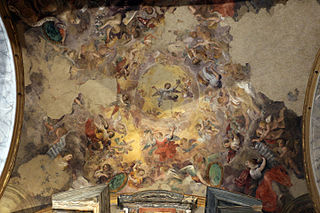
Giovanni Tuccari (1667–1743) was an Italian painter during the Baroque period, active in Sicily.

Lorenzo Pasinelli was an Italian painter active mainly in Bologna during the late Baroque period.

Filippo Lauri was an Italian painter of the Baroque period, active mainly in Rome.
Andrea Commodi (1560–1638) was an Italian painter of the early-Baroque period. Born in Florence, but mostly active in Rome, he was a pupil of the painter Cigoli. He painted frescoes in the sacristy of San Carlo ai Catinari. In the Galleria degli Uffizi in Florence there is a preparatory sketch "Fall of the Angels. This is a sketch for a fresco ordered by pope Paulus V Borghese for his palace of Montecavallo on the Quirinale in Rome, but the fresco was never executed. One of his pupils was a juvenile Pietro da Cortona who moved to Rome and became one of the towering figures of the Italian Baroque. Another pupil was Giovanni Battista Stefaneschi (1582–1659).

Giuseppe Gambarini was an Italian painter of the late-Baroque period, active mainly in Bologna. He was a pupil of the painters Lorenzo Pasinelli and Cesare Gennari. He also painted frescoes in the Palazzo Buonaccorsi in Macerata. He is also called Gioseffo Gambarini. One of his pupils was Stefano Gherardini

Giovanni Battista Lama (1673–1748) was an Italian painter of the Baroque period, active mainly in Naples. He primarily painted historical canvases. Along with Paolo de Matteis, he was pupil to the painter Luca Giordano. In turn, the painter Antonio Capulongo was his pupil.
Events from the year 1620 in art.

Luigi Quaini (1643–1717) was an Italian painter of the Baroque period.

Francesco Allegrini da Gubbio (1587–1663) was an Italian painter of the Baroque period. His children, Flaminio and Angelica Allegrini, were also painters. Angelica painted a canvas for the church of San Francesco, Gubbio.

Sebastiano Galeotti (1656–1746) was a peripatetic Italian painter of the late-Baroque period, active in Florence, Genoa, Parma, Piacenza, Codogno, Lodi, Cremona, Milan, Vicenza, Bergamo, and Turin.
Alessandro Badiale (1626–1671) was an Italian painter and engraver of the Baroque period, active in Bologna. He was a pupil of Flaminio Torre. Among his etchings are prints of Virgin seated with the Infant Jesus, between St. Philip Neri and St. Anthony of Padua, a Deposition and a Holy Family after Flaminio Torre. He also made a Madonna with Child, who holds a cross and an apple after Cignani.

Giovanni Maria Viani (1636–1700) was an Italian painter of the Baroque period, active in Bologna.
Baldassare Bianchi was an Italian painter of the Baroque period.

Antonio Barbalonga or Barbalunga, also called Antonio Alberti, was an Italian painter of the Baroque period.

Girolamo Troppa (1637–1710) was an Italian painter of the Baroque period, depicting mainly sacred subjects.
Giulio Cesare Milani was an Italian painter of the Baroque.
Vicenzo Gotti was an Italian painter of the Baroque period.

Domenico Parodi was an Italian painter, as well as a sculptor and architect, of the late-Baroque. He was the son of the famous Genoese sculptor Filippo Parodi and the older brother of the Baroque painter Giovanni Battista Parodi (1674-1730)

Giuseppe Maria Mitelli (1634–1718) was an Italian engraver and painter of the Baroque period. He was the son of the prominent quadratura painter Agostino Mitelli. The younger Mitelli was best known for his prolific engravings, in a great variety of subjects, including scenes from grand epics to mundane page boards for games of chance using dice, Tarot cards, and an Iconophor with anthropomorphized alphabets. He also engraved genre subjects, allegories, moralistic scenes, but even some bizarre cartoons that could be interpreted as sometimes provocatively subversive, or presciently revolutionary, and sometimes imaginatively bizarre. He often depicted dwarfs engaged in buffoonery or satirical depictions of aphorisms, which recalls the Bambocciate di nani or arte pigmeo of genre painter Faustino Bocchi (1659–1742).













